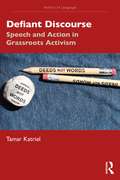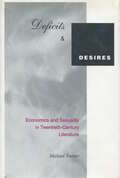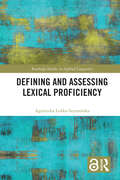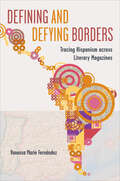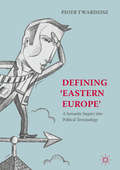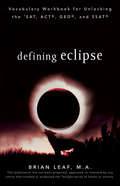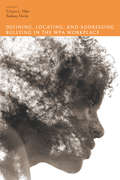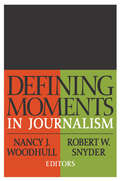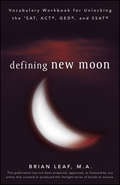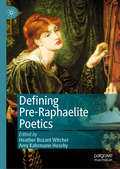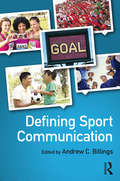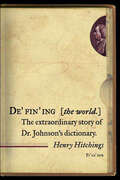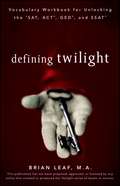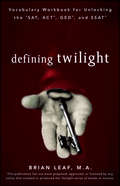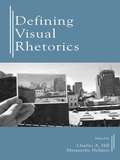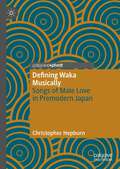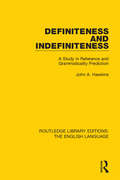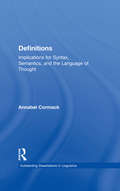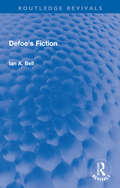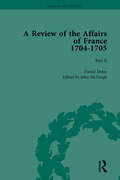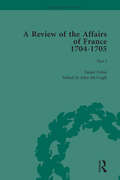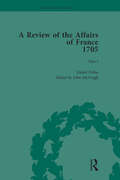- Table View
- List View
Defiant Discourse: Speech and Action in Grassroots Activism
by Tamar KatrielIn this timely and innovative book, Tamar Katriel takes a language and discourse-centred approach to the subject of peace activism in Israel-Palestine, one of the most significant political issues of our time, while also posing more general questions about the role played by language in activist movements – how activists themselves conceptualize their speech and its relationship to action. Viewing activism as a globalized cultural formation that gives shape and meaning to grassroots organizations' struggles for political change, this book explores the relations between the cultural categories of speech and action as constructed and evaluated in activist contexts. It focuses on the specific empirical field of defiant discourse associated with the soldierly role in Israeli culture, using it to offer an in-depth exploration of the cultural underpinnings of defiant speech. Katriel interrogates discourse-centered activism as part of social movements' action repertoires on the one hand, and of the local cultural construction of speech cultures on the other. This is critical reading for all students and scholars studying activism and social movements within linguistics, Middle Eastern studies, peace studies, and communication studies.
Deficits and Desires: Economics and Sexuality in Twentieth-Century Literature
by Michael TratnerThis book examines the effects on literary works of a little-noted economic development in the early twentieth century: individuals and governments alike began to regard going into debt as a normal and even valuable part of life. The author also shows, surprisingly, that the economic changes normalizing debt paralleled and intersected with changes in sexual discourse. In Victorian novels, sex and debt are considered dangerous activities that the young should avoid in order to save and invest toward eventual marriage and a home. In twentieth-century texts, however, it often seems acceptable to go into debt and engage in sex before marriage. These literary representations followed social transformations as both economic and sexual discourse moved from the logic of saving and production to the logic of circulation. In Keynesian economics and consumerism, governments and individuals were actually encouraged to borrow and to spend more in order to increase demand and keep money circulating. In twentieth-century sexual treatises, people were similarly encouraged to indulge their desires, as pent-up states were considered as deleterious to the physical body as they were to the economic. In this book, the author traces these social transformations by examining twentieth-century literary works and films that are structured around contrasts between repressive and expansive forms of economics and sexuality. He studies a range of authors, including James Joyce, F. Scott Fitzgerald, Virginia Woolf, Ezra Pound, Zora Neale Hurston, and Frank Capra. The book ends with the 1960s, because after that decade deficits no longer seemed the cure for anything, and the advocacy of sexual indulgence dwindled. For half a century, however, the intersections of sexual and economic discourses created a sense that society was on the verge of a vast transformation. The artists studied in this book were fascinated by such a prospect, but remained ambivalent, as it seemed that their dreams of escaping dull bourgeois life and ending repression were becoming true because of the influence of the crassest economic policies.
Defining and Assessing Lexical Proficiency (Routledge Studies in Applied Linguistics)
by Agnieszka Leńko-SzymańskaThis comprehensive account of performance-based assessment of L2 lexical proficiency analyzes and compares two of the primary methods of evaluation used in the field and unpacks the ways in which they tap into different dimensions of one model of lexical competence and proficiency. This book builds on the latest research on performance-based assessment, which has most recently pointed to the application of more quantitative measures to L2 data, to systematically explore the qualitative method of using human raters in assessment exercises and the quantitative method of using automatic computation of statistical measures of lexis and phraseology. Supported by an up-to-date review of the existing literature, both approaches’ unique features are highlighted but also compared to one another to provide a holistic overview of performance-based assessment as it stands today at both the theoretical and empirical level. These findings are exemplified in a concluding chapter, which summarizes results from an empirical study looking at a range of lexical and phraseological features and human raters’ scores of over 150 essays written by both L2 learners of English and native speakers. Taken together, the volume challenges existing tendencies within the field which attempt to use one method to validate one another by demonstrating their capacity to indicate very different elements of lexical proficiency, thereby offering a means by which to better conceptualize performance-based assessment of L2 vocabulary in the future. This book will be of interest to students and researchers working in second language acquisition and applied linguistics research, particularly those interested in issues around assessment, vocabulary acquisition, and language proficiency.
Defining and Assessing Lexical Proficiency (Routledge Studies in Applied Linguistics)
by Agnieszka Leńko-SzymańskaThis comprehensive account of performance-based assessment of L2 lexical proficiency analyzes and compares two of the primary methods of evaluation used in the field and unpacks the ways in which they tap into different dimensions of one model of lexical competence and proficiency.This book builds on the latest research on performance-based assessment, which has most recently pointed to the application of more quantitative measures to L2 data, to systematically explore the qualitative method of using human raters in assessment exercises and the quantitative method of using automatic computation of statistical measures of lexis and phraseology. Supported by an up-to-date review of the existing literature, both approaches’ unique features are highlighted but also compared to one another to provide a holistic overview of performance-based assessment as it stands today at both the theoretical and empirical level. These findings are exemplified in a concluding chapter, which summarizes results from an empirical study looking at a range of lexical and phraseological features and human raters’ scores of over 150 essays written by both L2 learners of English and native speakers. Taken together, the volume challenges existing tendencies within the field which attempt to use one method to validate one another by demonstrating their capacity to indicate very different elements of lexical proficiency, thereby offering a means by which to better conceptualize performance-based assessment of L2 vocabulary in the future.This book will be of interest to students and researchers working in second language acquisition and applied linguistics research, particularly those interested in issues around assessment, vocabulary acquisition, and language proficiency.The Open Access version of this book, available at http://www.taylorfrancis.com, has been made available under a CC BY NC ND 4.0 license.
Defining and Defying Borders: Tracing Hispanism across Literary Magazines (LATINOAMERICANA)
by Vanessa FernándezTracing heated exchanges between Spanish and Latin American intellectuals that took place in journals, magazines, and newspapers in the early twentieth century, Defining and Defying Borders details how borders and boundaries were contested within a medium that simultaneously crossed borders and defined boundaries. Vanessa Marie Fernández demonstrates that print media is an invaluable resource for scholars because it offers a nuanced perspective of the complex postcolonial relationship between Spain and Latin America that shaped aesthetic production within and beyond national boundaries. Presenting inclusive paradigms that are at once able to transcend borders, acknowledge national boundaries, and account for empire, Defining and Defying Borders illustrates that investigating journals, magazines, and newspapers is crucial to better understanding postcolonial literary and cultural production.
Defining ‘Eastern Europe’: A Semantic Inquiry Into Political Terminology
by Piotr TwardziszThis book offers a linguistic-semantic analysis of the expression ‘Eastern Europe’ in international English-language media discourse and academic discourse. Interdisciplinary in nature, it provides insights beyond semantics and lexicology, commenting on the politics, history, economy and culture of the region. Its thorough analysis of ‘Eastern Europe’ as a linguistic entity, surrounded and affected by other linguistic entities, allows for a systematic description of the term’s linguistic ‘behaviour’ in specialist written discourse. The author measures the ‘quantity’ and ‘quality’ of ‘Eastern Europe’ in specialist discourse, painting a holistic picture of how it appears in English-language quality texts published in the last twenty-five years. This book will appeal to students and scholars of cognitive linguistics, semantics, lexicology and lexicography, and to specialists working on history, political theory and international relations as they relate to Eastern Europe.
Defining Eclipse: Vocabulary Workbook For Unlocking The Sat, Act, Ged, And Ssat
by Brian LeafThe most captivating way to master vocabulary for the SAT, ACT, GED, and SSAT examsJoin Bella, Jacob, and Edward as you learn more than 600 vocabulary words for the SAT, ACT, GED, and SSAT! With hundreds of new vocabulary words, this book can be used completely on its own or as a follow-up to DefiningTwilight and Defining New Moon.You'll use this vocabulary workbook side-by-side with your own copy of Stephenie Meyer's Eclipse. Each chapter of the workbook gives you eight words taken from Eclipse, with page references for you to read the words in the context of your favorite novel. Once you have a grip on the words and their meanings, you'll take SAT, ACT, GED, and SSAT drills to test and integrate your new vocabulary skills. Improve your vocabulary skills to get into the college of your dreamsLearn synonyms and memorization toolsOther best-selling titles by Brian Leaf: Defining Twilight and Defining New MoonWhether you're on Team Edward or Team Jacob, any fan of the Twilight saga can turn to Defining Eclipse to master vocabulary for the SAT, ACT, GED, and SSAT exams.
Defining, Locating, and Addressing Bullying in the WPA Workplace
by Cristyn L. Elder Bethany ElderDefining, Locating, and Addressing Bullying in the WPA Workplace is the first volume to take up the issue of bullying in writing programs. Contributors to this collection share their personal stories and analyze varieties of collegial malevolence they have experienced as WPAs with consequences in emotional, mental, and physical health and in personal and institutional economies. Contributors of varying status in different types of programs across many kinds of institutions describe various forms of bullying, including microaggressions, incivility, mobbing, and emotional abuse. They define bullying as institutional racism, “academic systemic incivility,” a crisis of insularity, and faculty fundamentalism. They locate bullying in institutional contexts, including research institutions, small liberal arts colleges, community colleges, and writing programs and writing centers. These locations are used as points of departure to further theorize bullying and to provide clear advice about agentive responses. A culture of silence discourages discussions of this behavior, making it difficult to address abuse. This silence also normalizes patterns and cultivates the perception that bullying arises naturally. Defining, Locating, and Addressing Bullying in the WPA Workplace helps the field to name these patterns of behaviors as bullying and resist ideologies of normalcy, encouraging and empowering readers to take an active role in defining, locating, and addressing bullying in their own workplaces. Contributors: Sarah Allen, Andrea Dardello, Harry Denny, Dawn Fels, Bre Garrett, W. Gary Griswold, Amy C. Heckathorn, Aurora Matzke, Staci Perryman-Clark, Sherry Rankins-Robertson, Erec Smith
Defining Moments in Journalism
by Nancy J. Woodhull Robert W. SnyderMost great transformations are not apparent as we live through them. Only in hindsight do individual moments acquire layers of meaning that give them great significance. Looking back is not something that comes naturally to journalists, immersed as they are in breaking events and relentless deadlines. But there is still good reason for journalists, scholars, and people who care about journalism to think about the critical episodes in its recent evolution. In Defining Moments in Journalism, such authors vividly describe episodes of this kind. Some of the chapters and contributors include: "The Lessons of Little Rock" by Harry S. Ashmore; "Vietnam and War Reporting" by Peter Arnett; "Photo-journalists--Visionaries Who Have Changed Our Vision" by Jane M. Rosett; "The Weight of Watergate" by Ellen Hume; "Women Sportswriters--Business as Usual" by Mary Schmitt; "The Connie Chung Phenomenon" by Somini Sengupta; and "Covering Politics--Is There a Female Difference?" by Judy Woodruff. The years since the Great Depression and World War II have seen vast changes in America and also in its journalism. Journalists' relationship to power and authority is more complex; the press corps has become more diverse; the technology of news reporting is almost unrecognizably different from that of fifty years ago; and economic reorganization of the media has bundled news and entertainment organizations into conglomerates of extraordinary size. 'Defining Moments in Journalism' is a fascinating read for communications scholars and professionals, historians, and political scientists.
Defining New Moon: Vocabulary Workbook For Unlocking The Sat, Act, Ged, And Ssat
by Brian Leaf"Brian Leaf has done it again! Just as Defining Twilight did, Defining New Moon continues to help students improve their vocabulary while reading Stephenie Meyer's New Moon." -Peter Facinelli (Dr. Carlisle Cullen in the Twilight saga movies). Why is Bella desolate and haggard? Will Jacob win her over with his infectious affability? Can Edward dare to flout the rules and summon the belligerent ire of the Volturi? State your allegiance: Team Edward or Team Jacob? Join Bella, Jacob, and Edward as you learn more than 600 vocabulary words for the SAT, ACT, GED, and SSAT! With hundreds of new vocabulary words, this book can be used completely on its own or as a follow-up to Defining Twilight. Use this workbook side-by-side with your own copy of Stephenie Meyer's New Moon! Each chapter of the workbook gives you eight words taken from New Moon, with page references for you to read the words in the context of your favorite novel. Define the words on your own before turning back to the workbook for their actual definitions. Take SAT, ACT, GED, and SSAT drills and quizzes to review and integrate what you've learned. Plus, you'll learn synonyms, Latin word parts, and memorization tools throughout the workbook.
Defining Pre-Raphaelite Poetics
by Heather Bozant Witcher Amy Kahrmann HusebyDefining Pre-Raphaelite Poetics offers a range of Pre-Raphaelite literary scholarship, provoking innovative discussions into the poetic form, gender dynamics, political engagement, and networked communities of Pre-Raphaelitism. The authors in this collection position Pre-Raphaelite poetics broadly in the sense of poiesis, or acts of making, aiming to identify and explore the Pre-Raphaelites’ diverse forms of making: social, aesthetic, gendered, and sacred. Each chapter examines how Pre-Raphaelitism takes up and explores modes of making and re-making identity, relationality, moral transformations, and even, time and space. Essays explore themes of formalist or prosodic approaches, expanded networks of literary and artistic influence within Pre-Raphaelitism, and critical legacies and responses to Pre-Raphaelite poetry and arts, codifying the methods, forms, and commonalties that constitute literary Pre-Raphaelitism.
Defining Sport Communication
by Andrew C. BillingsDefining Sport Communication is a comprehensive resource addressing core topics and issues, including humanistic, organizational, relational, and mediated approaches to the study of sport communication. It provides foundational work in sport communication for students and scholars, reflecting the abundance of research published in recent years and the ever-increasing interest in this area of study. Bringing together scholars from various epistemological viewpoints within communication, this volume provides a unique opportunity for defining the breadth and depth of sport communication research. It will serve as a seminal reference for existing scholarship while also providing an agenda for future research.
Defining the World: The Extraordinary Story of Dr. Johnson's Dictionary
by Henry Hitchings&“[A] marvelous account&” of Johnson&’s towering achievement, nearly a decade of labor and linguistic fact-finding, presented by &“a buoyant, zestful writer&” (The Boston Globe). By the early eighteenth century, France and Italy had impressive lexicons, but there was no authoritative dictionary of English. Impelled by a mixture of national pride and commercial expedience, the prodigious polymath Samuel Johnson embraced the task, turning over the garret of his London home to the creation of his own giant dictionary. Johnson imagined that he could complete the job in three years. But the complexity of English meant that his estimate was wildly inadequate. Only after he had expended nearly a decade of his prime on the task did the dictionary finally appear—magisterial yet quirky, dogmatic but generous of spirit, and steeped in the richness of English literature. It would come to be seen as the most important British cultural monument of the eighteenth century, and its influence fanned out across Europe and throughout Britain&’s colonies—including, crucially, America. Brilliantly entertaining and enlightening, Defining the World is the story of Johnson&’s heroic endeavor. In alphabetically sequenced chapters, Henry Hitchings describes Johnson&’s adventure—his ambition and vision, his moments of despair, the mistakes he made along the way, and his ultimate triumph.
Defining Twilight: Vocabulary Workbook for Unlocking the *SAT, ACT®, GED®, and SSAT®
by Brian LeafCan you resist the allure of Edward's myriad charms--his ocher eyes and tousled hair, the cadence of his speech, his chiseled alabaster skin, and his gratuitous charm? Will you hunt surreptitiously and tolerate the ceaseless deluge in Forks to evade the sun and uphold the facade? Join Edward and Bella as you learn more than 600 vocabulary words to improve your score on the SAT, ACT, GED, and SSAT exams! Use this workbook side-by-side with your own copy of Stephenie Meyer's Twilight! * Each chapter of the workbook gives you eight words taken from Twilight, with page references for you to read the words in the context of your favorite novel * Define the words on your own before turning back to the workbook for their actual definitions * At the end of each section you'll take SAT, ACT, GED, and SSAT drills and quizzes to review and integrate what you've learned * Plus, you'll learn synonyms, Latin word parts, and memorization tools throughout the workbook.
Defining Twilight: Vocabulary Workbook For Unlocking The 'sat, Act', Ged', And Ssat'
by Brian LeafCan you resist the allure of Edward's myriad charms--his ocher eyes and tousled hair, the cadence of his speech, his chiseled alabaster skin, and his gratuitous charm? Will you hunt surreptitiously and tolerate the ceaselessdeluge in Forks to evade the sun and uphold the facade? Join Edward and Bella as you learn more than 600 vocabulary words to improve your score on the *SAT, ACT®, GED®, and SSAT® exams!Use this workbook side-by-side with your own copy of Stephenie Meyer's Twilight!Each chapter of the workbook gives you eight words taken from Twilight, with page references for you to read the words in the context of your favorite novelDefine the words on your own before turning back to the workbook for their actual definitionsAt the end of each section you'll take SAT, ACT, GED, and SSAT drills and quizzes to review and integrate what you've learnedPlus, you'll learn synonyms, Latin word parts, and memorization tools throughout the workbook
Defining Visual Rhetorics
by Charles A. Hill Marguerite HelmersImages play an important role in developing consciousness and the relationship of the self to its surroundings. In this distinctive collection, editors Charles A. Hill and Marguerite Helmers examine the connection between visual images and persuasion, or how images act rhetorically upon viewers. Chapters included here highlight the differences and commonalities among a variety of projects identified as "visual rhetoric," leading to a more precise definition of the term and its role in rhetorical studies. Contributions to this volume consider a wide variety of sites of image production--from architecture to paintings, from film to needlepoint--in order to understand how images and texts work upon readers as symbolic forms of representation. Each chapter discusses, analyzes, and explains the visual aspect of a particular subject, and illustrates the ways in which messages and meaning are communicated visually. The contributions include work from rhetoric scholars in the English and communication disciplines, and represent a variety of methodologies--theoretical, textual analysis, psychological research, and cultural studies, among others. The editors seek to demonstrate that every new turn in the study of rhetorical practices reveals more possibilities for discussion, and that the recent "turn to the visual" has revealed an inexhaustible supply of new questions, problems, and objects for investigation. As a whole, the chapters presented here demonstrate the wide range of scholarship that is possible when a field begins to take seriously the analysis of images as important cultural and rhetorical forces. Defining Visual Rhetorics is appropriate for graduate or advanced undergraduate courses in rhetoric, English, mass communication, cultural studies, technical communication, and visual studies. It will also serve as an insightful resource for researchers, scholars, and educators interested in rhetoric, cultural studies, and communication studies.
Defining Visual Rhetorics
by Charles A. Hill Marguerite HelmersImages play an important role in developing consciousness and the relationship of the self to its surroundings. In this distinctive collection, editors Charles A. Hill and Marguerite Helmers examine the connection between visual images and persuasion, or how images act rhetorically upon viewers. Chapters included here highlight the differences and commonalities among a variety of projects identified as "visual rhetoric," leading to a more precise definition of the term and its role in rhetorical studies. Contributions to this volume consider a wide variety of sites of image production--from architecture to paintings, from film to needlepoint--in order to understand how images and texts work upon readers as symbolic forms of representation. Each chapter discusses, analyzes, and explains the visual aspect of a particular subject, and illustrates the ways in which messages and meaning are communicated visually. The contributions include work from rhetoric scholars in the English and communication disciplines, and represent a variety of methodologies--theoretical, textual analysis, psychological research, and cultural studies, among others. The editors seek to demonstrate that every new turn in the study of rhetorical practices reveals more possibilities for discussion, and that the recent "turn to the visual" has revealed an inexhaustible supply of new questions, problems, and objects for investigation. As a whole, the chapters presented here demonstrate the wide range of scholarship that is possible when a field begins to take seriously the analysis of images as important cultural and rhetorical forces. Defining Visual Rhetorics is appropriate for graduate or advanced undergraduate courses in rhetoric, English, mass communication, cultural studies, technical communication, and visual studies. It will also serve as an insightful resource for researchers, scholars, and educators interested in rhetoric, cultural studies, and communication studies.
Defining Waka Musically: Songs of Male Love in Premodern Japan
by Christopher HepburnThis book considers how music, musicality, and ideologies of musicality are working within the specific construction of waka on the theme of male love in Kitamura Kigin’s Iwatsutsuji (1676) and Ihara Saikaku’s Nanshoku ōkagami (1687) by using a modified generative theory of music. This modified theory seeks to get at the interdependent meanings that may exist among the music, image, and the text of the waka in question. In all, this study guides the reader through five waka on the theme of male love and demonstrates not only how each waka is inherently musical but how the image and text may interdependently relate to the ways in which premodern Japanese song poets may not only have thought in and with sound but may have also utilized a diverse array of musical gestures to construct new objects of knowledge. In the case of this study, these new objects of knowledge seem to have aided in situating a changing musicopoetics that aligned with changing constructions of male desire.
Definiteness and Indefiniteness: A Study in Reference and Grammaticality Prediction (Routledge Library Editions: The English Language #11)
by John A. HawkinsFirst published in 1988, this book is concerned with the definite and indefinite articles in English. It provides an integrated pragmatic-semantic theory of definite and indefinite reference, on the basis of which, many co-occurance restrictions between articles and non-modifiers are explained. At the general theoretical level, this book looks at the role of semantics in the prediction of all and only the grammatical sentences of a language. A generalisation is proposed uniting semantic oppositions underlying ungrammaticality with syntactic oppositions between conditions of application on transformational generative rules. A procedure is suggested for distinguishing semantic from syntactic causes of ungrammaticality. At a more particular level, the book explores the nature of reference. It examines an important selection of subjects such as the contrast between definiteness and indefiniteness, the relationship between definite and demonstrative reference, and the relationship between pragmatic and logical aspects of determining meaning.
Definitions: Implications for Syntax, Semantics, and the Language of Thought (Outstanding Dissertations in Linguistics)
by Annabel CormackThe answer to the question "How can we understand and use a definition?" provides new constraints on natural language and on the internal language in which meaning is mentally represented. Most syntax takes the sentence as the basic unit for well-formedness, but definitions force us to focus on words and phrases, and hence to focus on compositional syntax in parallel with compositional semantics. This study examines both dictionary definitions and definitions from textbooks, from the points of view of their syntax, semantics, and use for learning word meaning. The tools used throughout are Principles and Parameters syntax, Relevance theoretic pragmatics, Model theoretic semantics, and the formal theory of definitions. The analyses argue that because phrases can be understood in isolation, some standard syntactic analyses must be modified. 'NP movement' has to be reanalysed as transmission of theta roles. These ideas are then applied to a variety of adjectives which take propositional complements. The final chapter argues that for definitions to be understood, the syntax of the Language of Thought must be close to that of Natural Language in specifiable way.
Defoe's America
by Dennis ToddThe Americas appear as an evocative setting in more than half of Daniel Defoe's novels, and often offer a new beginning for his characters. In the first full-length study of Defoe and colonialism, Dennis Todd explores why the New World loomed so large in Defoe's imagination. By focusing on the historical contexts that informed Defoe's depiction of American Indians, African slaves, and white indentured servants, Dennis Todd investigates the colonial assumptions that shaped his novels and, at the same time, uncovers how Defoe used details of the American experience in complex, often figurative ways to explore the psychological bases of the profound conversions and transformations that his heroes and heroines undergo. And by examining what Defoe knew and did not know about America, what he falsely believed and what he knowingly falsified, Defoe's America probes the doubts, hesitancies, and contradictions he had about the colonial project he so fervently promoted.
Defoe's Fiction (Routledge Revivals)
by Ian A. BellFirst published in 1985, Defoe’s Fiction explores Defoe’s work by considering it in the context of its genre. The book highlights the difficulty of placing Defoe’s fiction in the most appropriate context due to it being aimed primarily at a popular market, in contrast to the more literary productions of Pope, Swift, or Addison. It also comments on the trend of focusing on Defoe’s irony or emphasising his mimetic power. In doing so, it seeks to explain, rather than judge, Defoe’s achievement by looking at his whole body of work in the context of its genre. Defoe’s Fiction will appeal to those with an interest in Defoe, comparative literature, and the history of literary criticism.
Defoe's Review 1704-13, Volume 1 (Defoe's Review 1704–13)
by John McVeaghOne of Daniel Defoe's greatest achievements was the writing and publication of his "Review". Covering his many interests, both contemporary and historical, Defoe published his journal twice and latterly three times a week. This volume reproduces the "Review" from the year 1704.
Defoe's Review 1704-13, Volume 1 (Defoe's Review 1704–13)
by John McVeaghOne of Daniel Defoe's greatest achievements was the writing and publication of his "Review". Covering his many interests, both contemporary and historical, Defoe published his journal twice and latterly three times a week. This volume reproduces the "Review" from the year 1704.
Defoe's Review 1704-13, Volume 2 (Defoe's Review 1704–13)
by John McVeaghThis volume is an important and rare work in the political and literary history of England and for a Defoe scholar. It is one of the earliest examples of the political periodical, and includes discussions on the parliamentary election of 1705 and Defoe's weekly Scandal Club correspondence.
